In Conversation: Shanésia Davis and Brian Keys
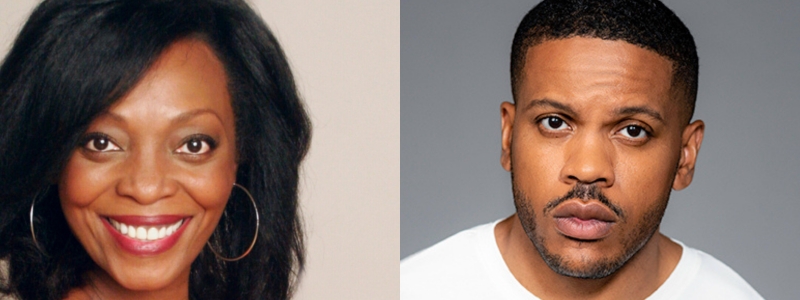
Shanésia Davis and Brian Keys are dreamers. Playing Lena (Mama) Younger and Walter Lee Younger in Lorraine Hansberry’s A Raisin in the Sun, Davis and Keys recently met with Associate Director of Marketing Camille Oswald to discuss the relationship between the specific and the universal, the definition of home, and the beauty of the South Side.
What followed was a conversation both thoughtful and personal, and deeply rooted in the themes of the play, demonstrating A Raisin in the Sun’s perpetual relevance. Below is an excerpt of their discussion.
What is your background with A Raisin in the Sun?
Brian: I read the play in seventh grade. I was Mr. Lindner. That’s what happens when the school is 100% Black kids—somebody’s got to do it! [laughs]
Shanésia: We read it in high school. Just as a side note: I read the play again last night [before this conversation]. I told my daughter—who’s in high school—what I was reading, and she said, “We’re reading that!” I also had the wonderful experience of playing Ruth years ago at Kansas City Rep; the most challenging aspect of the role, outside of creating the character, was the language—the musicality of the language. And now, to be fortunate enough to play Lena Younger? How does that happen?
Lorraine Hansberry has said, “In order to create something universal, you must pay very great attention to the specific.” How does that apply to A Raisin in the Sun?
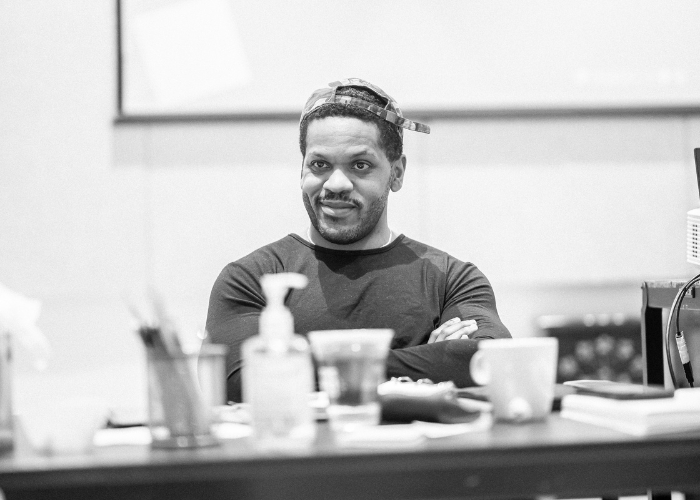
Brian: In this play, if you focus on the specific human beings who are living in this world, you’ll find there’s a lot of relatability. There’s a false barrier that was put up based on skin color to make it seem like there’s a big chasm between us as humans, but everybody in this world—[we’re] all dreamers. We all come into this world as dreamers. The world can take that out of us, but there are many who are fortunate to hold on and keep a grasp on that dream.
Shanésia: What is the American Dream? By whose standards do we live this dream, work towards this dream? I would rather have a dream and not reach it, than to not have any at all. What’s your passion? What’s your love? Go for that. Even if you don’t achieve it, it’s not a failure.
Brian: It is very rooted in humanity. The specifics of humanity reflect the universality of humanity, and that’s the legacy.
Shanésia: The specifics of that universality that Lorraine Hansberry speaks about lie in the marginalization of Black people. It’s as fundamental as, Where can we live healthily, happily, and protected? To have the opportunity to want more, even if it’s just simply having a place to live where your child can go in the streets safely, play safely, and you can come to and from work. We’re still dealing with those issues today.
Brian: I can’t imagine being the first Black woman to have a show produced on Broadway—how people, the critics, would dissect it, and decode it, and try to make it something that it’s not. Like, Oh, this is a Black play. No. It’s human. We just so happen to be Black, but we’re human, you know? People will have their own interpretation of what the work is, but Lorraine wanted to reflect humanity—what she saw, the humans around her, the neighborhood, the world—everything.
Shanésia: In the introduction of A Raisin in the Sun written by Rober Nemiroff [Lorraine Hansberry’s exhusband and Literary Executor of her estate], he alludes to scenes being taken out for Broadway: the scene with the neighbor at the end, and a scene between Travis and Walter—a Black man, who was raised by a Black man, who is now raising a Black boy—that was modified. Going back to Ms. Hansberry, that says a lot about some of the challenges she faced; even though it was this trailblazing production to have on Broadway, there were still many concessions that were made in order for that to happen. In order to not make the audience uncomfortable.
What does this play teach us about home?
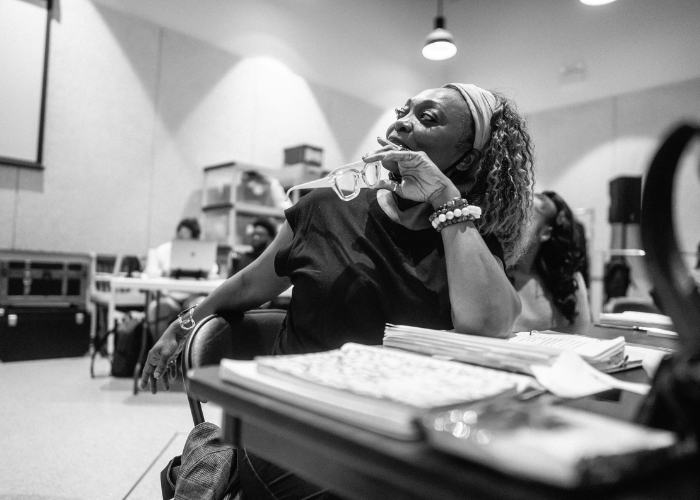
Shanesia: Being raised by a single mom, we moved a lot. After my divorce, I moved a lot as well, and one of the things that I tried to establish for my daughter was a sense of stability. At one point, I was so broken down, I was talking to my best friend, and she said, “You don’t understand. Wherever you are, that’s home to your daughter.” [With that experience] I understand what my mother went through, and now that she is eighty-five, I need to do something for her, so that at least she can understand that I understand what she went through. Just the fact that I have [my mother with me], and she has a home— that just means something to me, to provide for her. Home is what makes you feel safe: knowing that I have people in my house who I love, who I can provide for, who I can see when I want to. Knowing that I’m able to provide that for my mom is important to me—really important for me—because her mom did it for us. My grandmother, in Detroit. 20464 Monica. I will never forget that address.
I think important, too, is—where is the Younger family going to, right? Is it about assimilation, as Beneatha says? Of all the predominantly white neighborhoods, what is it about this neighborhood? It’s just something I think about as a human being, wondering why I would want to move over there. Would that feel like home?
Brian: The Great Migration, they had to make that choice. You’ve got to choose the lesser of two evils.
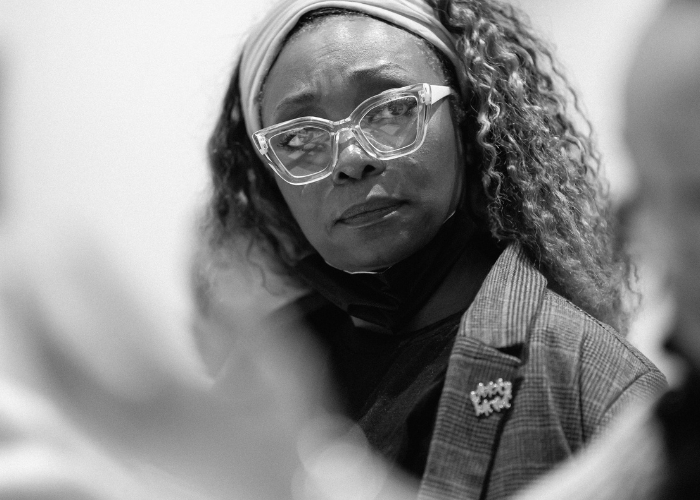
Shanésia: Do you call that home, where you know that you are in your community, you’re surrounded by people who look like you, but yet you’re not safe? Or do you go to a community where you know it’s not going to be safe, and you could take the necessary precautions, but you could be safe to a certain degree?
Brian: A home is very subjective. For me, it’s Where do I feel safe? Where do I feel loved? When I travel, go to different cities, I compare everything to Chicago—anywhere else just doesn’t feel like home. Something I wanted to mention, that you reminded me of: in this play, I feel like the men get too much focus. Maybe it’s my upbringing, but every time I read the pages, I’m like, This is about the women of the world. Being raised by a single mom and my grandmother, they don’t get enough credit. And I’m sure that echoes for a lot of mothers. What you’re doing matters.
Shanésia: You bring up a really good point: Mama is center, but Walter is the focus. Mama is the head of the house; however, she’s the head of the house because her husband passed away. Being a South Side single mom, there’s a label that happens, that you’re a strong Black woman. No, I’m not. I am a woman. I am a resilient Black woman. Resilience lasts longer than strength; resilience comes from the need to do what needs to be done, to raise your children, to protect your children. When I think about Lena and the words that she says—and this is the resilience she has—it’s all about love. She finds that joy in the love that she has for her children, her grandchildren. She finds love and joy in the hope, in the dream. Each character has to find their own joy that drives them.
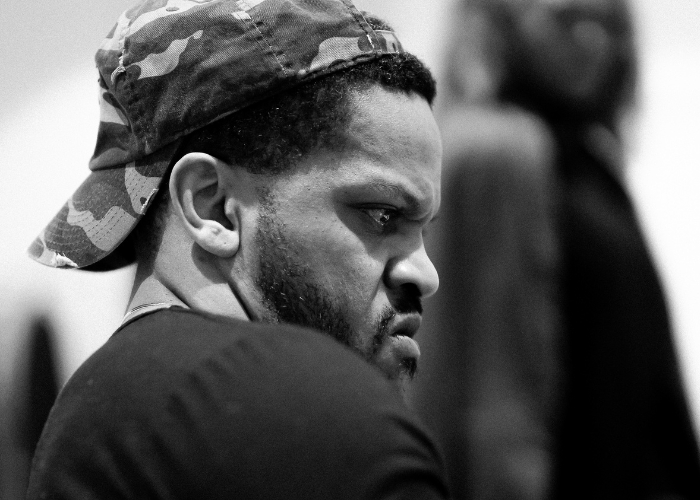
Brian: It’s a journey. In this world of the Younger family, everyone’s carrying this burden of grief. It’s hard to be joyous during grief. For myself, on the heels of losing my mom, every day is a choice: I’m going to try and be joyful today. I have responsibilities, I have to be a dad, and I’m going to go on that journey to find my joy. And if you wake up one day and you just don’t have that choice in you, I think that’s okay too. You’re still trying.
Can you speak about the importance of doing A Raisin in the Sun on the South Side?
Shanésia: It’s been over twenty years, so I guess I can say I’m an official South Sider. On the South Side, there are a lot of gems and young people who want to make their communities better. I would always see this little boy—maybe about ten or twelve years old—I would see him, he would ask for money, I’d give him some money, and I’d ask him what he read today. He was like, “I’ve got the books right here, ma’am. I was expecting you.” I wonder where that kid is today, but I hope that his love, his determination, his love for wanting to do more, to be more, whatever he got from those books…that says a lot. I never saw that anywhere but right here on the South Side.
Brian: I was introduced to a phrase through [the television series] The Chi: How can I be what I cannot see? Some may be coming to see the play, or may read the play, and they’re in a space where they’re not surrounded by either support of their dream, examples of their dream, or even the understanding that they are free to dream. The dream can thrive and survive in this environment. The notion may be, You can’t do anything—can’t be anything—coming from the South Side. You can. So many beautiful things come from the South Side of Chicago. To me, everything dope comes from the South Side of Chicago. I hold the South Side near and dear to my heart; I would not be who I am without the South Side.
Experience Lorraine Hansberry’s masterpiece set on the South Side, a stunning portrayal of a family’s fight for dignity and the right to dream, onstage from January 31 – March 2, 2025. Tickets are available online or by calling the Box Office at (773) 753-4472.
2 responses on “In Conversation: Shanésia Davis and Brian Keys”
Comments are closed.
Thank you for these words…They help me understand the play in a new sense
Terrific performances!